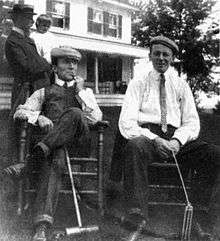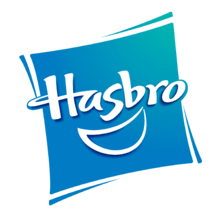Parker Brothers
 Logo designed by Arnold Ferdinand Arnold, 1964 | |
| Division | |
| Industry | Games |
| Fate | Purchased by Hasbro and reincorporated as Hasbro Gaming |
| Successor | Hasbro Gaming |
| Founded | 1883 (as George S. Parker Company) |
| Defunct |
1998 (company) 2009 (brand) |
| Headquarters | Beverly, Massachusetts, U.S. |
| Products |
Monopoly Ouija Cluedo/Clue Bop It Sorry! Aggravation Probe |
| Parent | Hasbro |
Parker Brothers was an American toy and game manufacturer which later became a brand of Hasbro. More than 1,800 games were published under the Parker Brothers name since 1883.[1] Among its products were Monopoly, Cluedo (licensed from the British publisher and known as Clue in North America), Sorry!, Risk, Trivial Pursuit, Ouija, Aggravation, Bop It, and Probe. The trade name became defunct with former products being marketed under the "Hasbro Gaming" label. However, in 2017, Hasbro revived the brand with the release of several new games which bear similarities with those of some of its previous better well known products.[2] [3][4]
History
Parker Brothers was founded by George S. Parker. Parker's philosophy deviated from the prevalent theme of board game design; he believed that games should be played for enjoyment and did not need to emphasize morals and values. He created his first game, called Banking, in 1883 when he was 16.[5] Banking is a game in which players borrowed money from the bank and tried to generate wealth by guessing how well they could do. The game included 160 cards which foretold their failures or successes. The game was so popular among family and friends that his brother, Charles Parker, urged him to publish it. George approached two Boston publishers with the idea, but was unsuccessful. Not discouraged, he spent $40 to publish 500 sets of Banking.[5] He eventually sold all but twelve copies, making a profit of $100.

Parker founded his game company, initially called the George S. Parker Company, in his hometown of Salem, Massachusetts in 1883.[6] When George's brother Charles joined the business in 1888, company's name was changed to its more familiar form. In 1898 a third brother, Edward H. Parker, joined the company. For many years, George designed most of the games himself, and wrote all the rules. Many games were based on important events of the day: Klondike was based on the Alaskan gold rush, and War in Cuba was based on the impending Spanish–American War.
The game industry was growing, and the company was becoming very profitable. In 1906, Parker Brothers published the game Rook, their most successful card game to this day, and it became the best-selling game in the country. During the Great Depression, a time when many companies went out of business, Parker Brothers released a new board game called Monopoly. Although the company had originally rejected the game in 1934, they decided to publish it the next year.[7] It was a success, and the company had difficulty keeping up with demand. The company continued to grow throughout the next several decades, producing such lasting games as Cluedo (released as Clue in North America), Risk, and Sorry!
Parker Brothers marketed its first puzzle in 1887. The most highly sought of Parker puzzles are the wooden Parker Pastimes. Parker also produced children's puzzles, as well as the Climax, Jig-A-Jig, Jig Wood, and Paramount lines. According to Jigsaw Puzzles: An Illustrated History and Price Guide, by Anne D. Williams, Parker Bros. closed the Pastime line in the 1950s and their die-cut puzzles were phased out in the late 1970s.[8]
Even after George Parker's death, the company remained family-owned until 1968 when General Mills purchased the company. After this, Parker Brothers produced the first Nerf ball, which became another major national hit. In the UK during the 1970s, Parker Bros. was the games division of Palitoy (also a General Mills company), and produced a variety of releases such as Escape from Colditz. By the turn of the decade, the company relocated to Beverly, Massachusetts.
The company began to produce electronic versions of their popular board games in the late 1970s and early 1980s. At this time, the company ventured into the toy market with the electronic action figure, Rom the Spaceknight, in 1977. Although the toy proved a failure, the licensed comic book published by Marvel Comics ran for years after the toy was discontinued. They also produced video games for various systems during the early 1980s, with home ports of many popular arcade games such as Konami's Frogger, Popeye, Gottlieb games such as Q*bert and Reactor, the first video games based on the Star Wars movies such as The Empire Strikes Back, Jedi Arena, and Death Star Battle, and more.
In early 1983, Parker Brothers spent US$15 million establishing a book publishing branch;[9] their first titles featured the American Greetings franchises, Care Bears and Strawberry Shortcake.[9][10] The branch published twelve titles by February 1984; sales of these books totalled 3.5 million units.[11] Parker Brothers also operated a record label around the same time; one of its releases, based on Coleco's Cabbage Patch Kids and involving Tom and Stephen Chapin titled Cabbage Patch Dreams,[11] was certified Gold by the Recording Industry Association of America (RIAA) in July 1984.[9]
In 1985, General Mills merged the company with their subsidiary Kenner; this new company, Kenner Parker Toys Inc., was acquired by Tonka in 1987.
Tonka, including Parker Brothers, was bought in 1991 for about $516 million by Hasbro which also owned the Milton Bradley Company.[12] Following the acquisition, Parker Brothers continued to have its corporate offices in Beverly, but production of the games were moved to Milton Bradley's headquarters in East Longmeadow.[13] In 1998, Parker Brothers and Milton Bradley were consolidated at the new Hasbro Games campus (based in Parker Brother's former headquarters).[14]
See also
References
- ↑ "Parker Brothers". Facebook. Retrieved July 11, 2013.
- ↑ Parker Brothers No Apologies "Parker Brothers No Apologies". Retrieved July 31, 2018.
- ↑ Parker Brothers Climb & Slide "Parker Brothers Climb & Slide". Retrieved July 31, 2018.
- ↑ Parker Brothers Mystery Game "Parker Brothers Mystery Game". Retrieved July 31, 2018.
- 1 2 The History of Toys Archived 2007-10-12 at the Wayback Machine.
- ↑ 90 Years of Fun, 1883-1973: the History of Parker Brothers. 1973.
- ↑ Monopoly Board Game – Parker Brothers Archived June 15, 2007, at the Wayback Machine.
- ↑ "Risk Online Game Reviews". Retrieved 25 April 2016.
- 1 2 3 Wojahn, Ellen (1988). "Fold". Playing by Different Rules. American Management Association (amacom). p. 217. ISBN 0-8144-5861-0.
- ↑ Dougherty, Philip H. (February 8, 1983). "Parker Bros. adding book publishing line". The Miami News. New York Times News Service. p. 8A. Retrieved August 5, 2010.
- 1 2 Gorov, Linda (February 9, 1984). "Parker Brothers giving (children's) music market a spin". The Boston Globe. The New York Times Company. Retrieved September 21, 2010. (Registration required (help)).
Parker's move comes on the heels of its 1983 entry into children's books. Its 12 books about Care Bears and Strawberry Shortcake sold an unprecedented 3.5 (million units).
- ↑ Ramirez, Anthony (1991-02-01). "Tonka Accepts Offer From Hasbro". The New York Times. ISSN 0362-4331. Retrieved 2016-10-14.
- ↑ "New Document". toyhistory.com. Retrieved 3 February 2017.
- ↑ "Hasbro : Investor Relations : News Release". corporate-ir.net. Retrieved 3 February 2017.
Further reading
- From Hostility to Reverence: 100 Years of African-American Imagery in Games
- Don Kader, "Collecting Black Memorabilia", Collectors' Showcase (September/October 1982), 16.
External links
- The Game Makers, a book by Philip Orbanes, chronicles the history of Parker Brothers
- Parker Brothers on the History Channel
- The story of Parker's early games
- New York Historical Society owns many examples of Parker Bros. games, such as:
- The Good Old Game of Corner Grocery, 1887
- Chivalry: The Greatest Modern Board Game of Skill
- Round the World Joe
- Young People's Geographical Game. Salem, MA: Parker Bros., ca. 1890
- Parker Brothers game listings and information in the Association for Games & Puzzles International's Game Catalog
- Parker Brothers game listings and information at BoardGameGeek
